D.2 Stellar Characteristics and Stellar Evolution
Stellar spectra (Absorbtion)
A star is assumed to radiate like a black body.
The stellar spectra can be used to identify:
- Surface temperature
-
Chemical composition
- Each dark line represents the absorption of light of a specific wavelength by a specific chemical element in the star’s atmosphere.
- Velocity and rotation (Doppler shifting of spectral lines) of Recessional velocity
- Magnetic field
| Type | Temperature | Hydrogen (Discrete energy level) | Absorption Line |
|---|---|---|---|
| Hot star | 25000K | Ionized (n=$\infty$) | None |
| Cooler star | 10000K | n=2 to n=3, n=4 | Infared |
| Cool star | 3000K | Ground state (n=1) | Ultraviolet |
- The hydrogen in the hot star is ionised, means the elections have left the hydrogen atoms. Thus, no bound electrons to absorb the photons to transfer to higher energy states.
- We can then infer that the hot star will not show any absorption lines at hydrogen length.
- n 越小,跃迁所需要的能量越多
Wien's law
Most of the enery is emitted around a wavelength called peak wavelength
$$ \lambda_{max}\cdot T=2.9\times 10^{-3} \textcolor{grey}{\text{Km}} $$
The Hertzsprung–Russell (HR) diagram
-
Main sequence - Most stars fall on a strip extending diagonally across the diagram from top left to bottom right
-
Red giants - Some large stars, reddish in colour, occupy the top right (large and cool)
- Above these are the red supergiants (very large and cool)
-
The bottom left is a region of small stars known as white dwarfs (small and hot)
Main sequence stars
A normal star that is undergoing nuclear fusion of hydrogen into helium.
- 90% of stars are main sequence star
- They produce energy by fusing hydrogen to helium, to counterbalance the collapse tendency under its heavy weight.
| Composition | Proportion |
|---|---|
| Hydrogen | 70% |
| Helium | 28% |
| Other heavier elements | 2% |
$$ \frac{L}{L_{\bigodot}}=(\frac{M}{M_{\bigodot}})^{3.5} $$
Red giants and red supergiants
Red giants are very large, cool, with reddish appearance.
Its luminosity bigger than main-sequence at the asme temperature.
- Having a central hot core surrounded by an enormous envelope of extremely tenuous gas.
Red supergiants are even larger and brighter than red giants.
White dwarfs
- Dim
- Small
- Hot
- Whitish
- Dense ($\rho_{Earth}\times 10^6$)
The mass-luminosity relation
$$ L \propto M^{3.5} $$
Cepheid variable stars
-
Cepheid variable's luminosity varies periodically from a minimum to a maximum.
- The reason for periodic variation in luminosity is the periodic expansion and contraction of the outer layers of the star.
- When the radiation rushes outward, it ionises helium atoms in the atmosphere of the star.
- The released electron heat the atmosphere up by collision, adding pressure to force the outer layer of the star to expand.
- Radiation can't leave the star since almost all heliums were ionised, the star begins to cool down and contract by its own weight.
- This process causing helium nuclei recombine with electrons and the cycle repeats.
The brightness of the star increase shaply and then fades off more gradually.
The periods being typically from a couple of days to a couple of months.
Astronomers can calculate the distance by measuring the difference of the apparent brightness to the predicted brightness.
The relation of radiation with luminosity:
- Outer layer was pulled inwards by gravity -> compressed -> more opaque/ less transparent
- Temperature inside the layer increases, building up internal pressure
- Oute layer is pushed outwards, the layer colls, presure falls, less dense -> more transparent, radiation escapes.
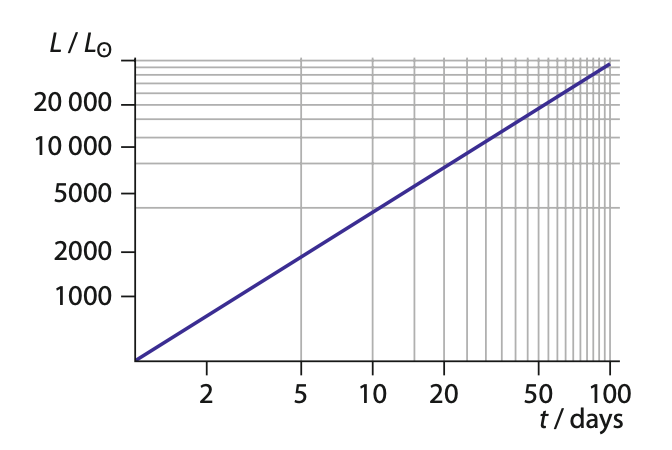 The relationship between peak luminosity and period for Cepheid stars.
The relationship between peak luminosity and period for Cepheid stars.
Make sure whether it is average luminosity or peak luminosity!
The light curve of cepheid stars.
Standard Candle
Stars of a known luminosity, obtained by measuring their periods
之所以叫Standard C,是因为b用CCD,L可以用Period
Mechanism for the periodic variation
-
As radiation rushes outwards it ionises helium atoms in the atmosphere of the star.
-
The freed electrons, through collisions, heat up the star's atmosphere.
-
This increases the pressure, which forces the outer layers of the star to expand.
-
When most of the helium is ionised, radiation now manages to leave the star, and the star cools down and begins to contract under its own weight.
-
This makes helium nuclei recombine with electrons, and so the cycle repeats as helium can again be ionised.
The star is brightest when the surface is expanding outwards at maximum speed.
Stellar evolution
-
Initially the star has a low surface temperature and so its position is somewhere to the right of the main sequence on the HR diagram.
-
As the star contracts under its own weight, gravitational potential energy is converted into thermal energy and the star heats up; it begins to move towards the main sequence. The time taken to reach the main sequence depends on the mass of the star; heavier stars take less time.
-
As a star is compressed more and more (under the action of gravity), its temperature rises and so does its pressure.
-
Eventually, the temperature in the core reaches $\bold{5\times 10^6K}$ to $\bold{10^7K}$ and nuclear fusion reactions commence, resulting in the release of enormous amounts of energy.
-
When about 12% of the hydrogen in the star has been used up in nuclear fusion, a series of instabilities develops in the star, upsetting the delicate balance between radiation pressure and gravitational pressure. The star will then begin to move away from the main sequence.
-
What happens next is determined mainly by the mass of the star.
For stars with a mass less than about eight solar masses (Low-mass stars, M<4-8M~sun~)
-
In low-mass stars, helium collects in the core of the star, surrounded by a thin shell of hydrogen and a bigger hydrogen envelope.
- Only hydrogen in the thin inner shell undergoes nuclear fusion to helium
-
The temperature and pressure of the helium build up and eventually helium itself begins to fuse (helium flash), with helium in a thin inner shell producing carbon in the core.
-
In the core, some carbon nuclei fuse with helium to form oxygen.
-
Oxygen is the heaviest element that can be produced in low-mass stars.
-
The temperature never rises enough for production of heavier elements.
-
The hydrogen in the thin shell is still fusing, so the star now has nuclear fusion in two shells, the H and He shells.
-
-
The huge release of energy blows away the outer layers of the star in an explosion called a planetary nebula
- Mass is thrown into space, leaving behind the carbon core (and some oxygen)
-
The star is now a stable but dead star, which becomes a white dwarf star later.
- No nuclear reactions take place in the core.
- The electrons behave as a gas
- The pressure they generate is what keeps the core from collapsing further under its weight
- This pressure is called electron degeneracy pressure and is the result of a quantum mechanical effect, referred to as the Pauli Exclusion Principle, which states that no two electrons may occupy the same quantum state.
-
Now exposed, and with no further energy source, the star is doomed to cool down to practically zero temperature and will then become a black dwarf.
Planetary nebula
The ejected envelope of a red giant star.
For stars with a mass greater than about eight solar masses
- The star moves off the main sequence and into the red supergiant area
- As the path moves to the right, ever-heavier elements are produced.
- The star is very hot in the core.
- Photons have enough energy at these temperatures to split nuclei apart;
- In about one second (!) millions of years, worth of nuclear fusion is undone.
- Nuclei are in turn ripped apart into individual protons and neutrons, so that in a very short time the star is composed mainly of protons, electrons, neutrons and photons.
- Because of the high densities involved, the electrons are forced into the protons, turning them into neutrons and producing neutrinos that escape from the star.
- The star’s core is now made up almost entirely of neutrons, and is still contracting rapidly.
- The Pauli Exclusion Principle may now be applied to the neutrons
- If they get too close to one another, a pressure develops to prevent them from getting any closer.
- But they have already done so, and so the entire core now rebounds to a larger equilibrium size.
- This rebound is catastrophic for the star, creating an enormous shock wave travelling outwards that tears the outer layers of the star apart.
- The Pauli Exclusion Principle may now be applied to the neutrons
- The resulting explosion, called a supernova, is much more violent than a planetary nebula. The energy loss from this explosion leads to a drastic drop in the temperature of the star, and it begins to collapse.
Neutron stars
A very dense star, consisting only of uncharged neutrons.
Chandrasekhar & Oppenheimer–Volkoff limits
Chandrasekhar limit (<8 solar mass)
If the mass of the core of a star is less than the Chandrasekhar limit of about 1.4 solar masses, it will become a stable white dwarf, in which electron pressure keeps the star from collapsing further.
Oppenheimer-Volkoff limit (>8 solar mass)
If the core is more massive than the Chandrasekhar limit but less than the Oppenheimer–Volkoff limit of about 2–3 solar masses, the core will collapse further until electrons are driven into protons, forming neutrons. Neutron pressure now keeps the star from collapsing further, and the star becomes a neutron star.
If the Oppenheimer–Volkoff limit is exceeded, the star will become a black hole.
- The star begins as a protostar
- Then enevolves to the main sequence
- Then becomes a red giant or supergiant.
- After a planetary nebula or supernova explosion, the core of the star develops into one of the three final stages of stellar evolution:
| Initial mass of star (in terms of solar masses) | Outcome |
|---|---|
| 0.08–0.25 | White dwarf with helium core |
| 0.25–8 | White dwarf with carbon core |
| 8–12 | White dwarf with oxygen/neon/ magnesium core |
| 12-40 | Neutron star |
| >40 | Black hole |
Nebula (Nebulae)
A cloud of dust, hydrogen, helium and other ionized gases. 70% of Hydrogen, 28% of Helium)
Generation:
- Ejected from a supernava explosion
- Hydrogen atoms = nuclei + electrons
Black hole
A singularity in space-time.


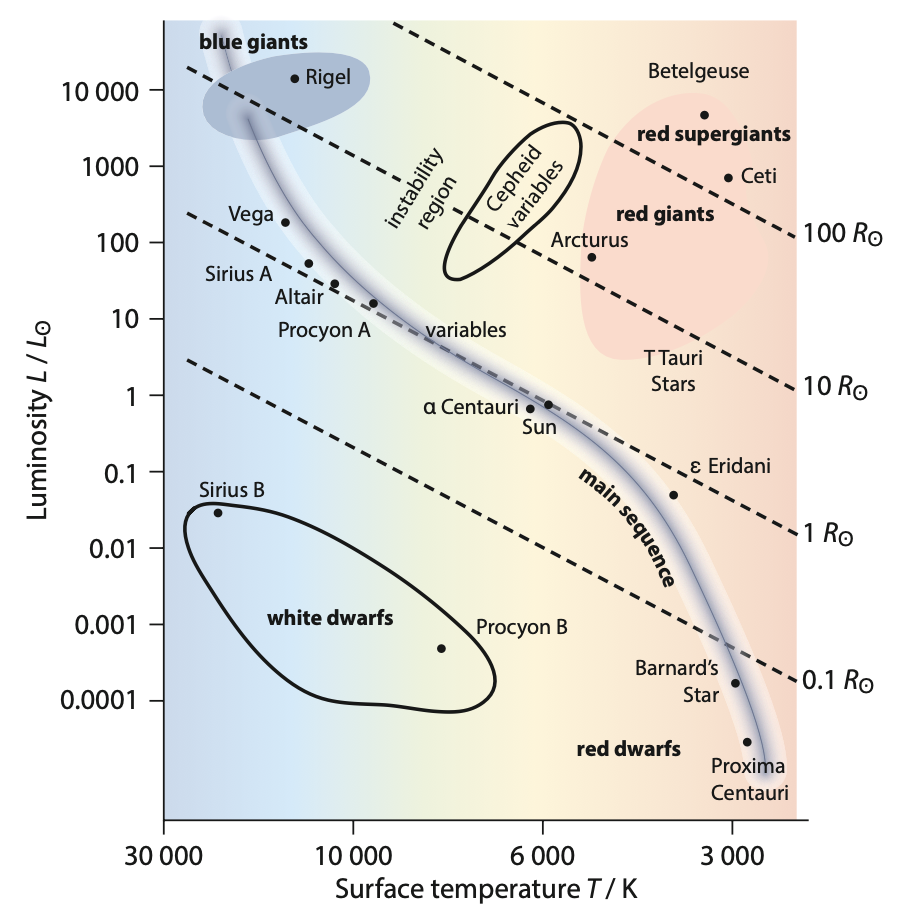
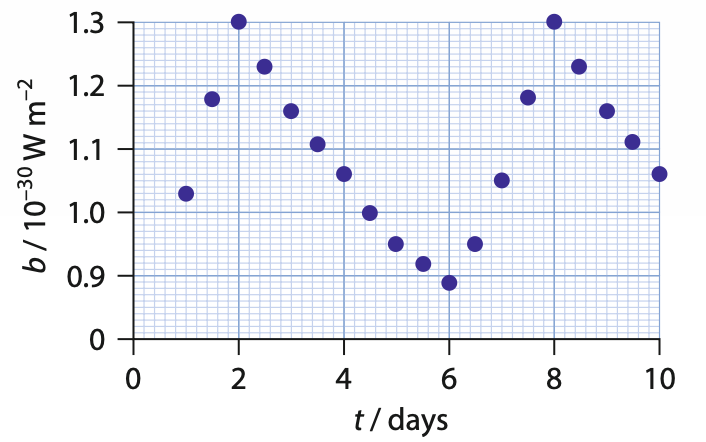

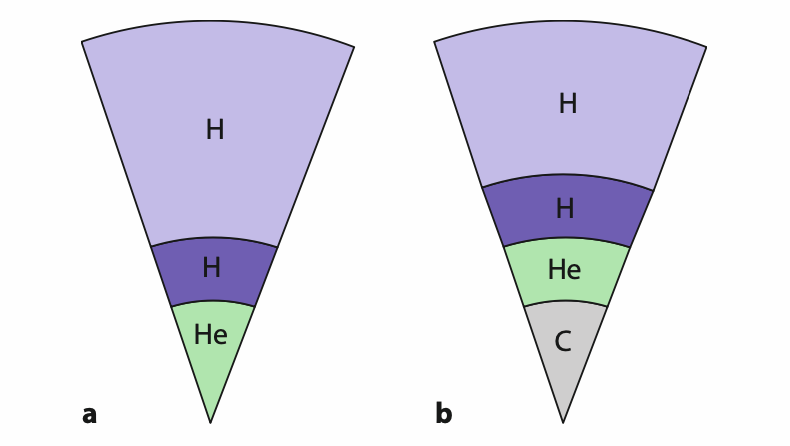
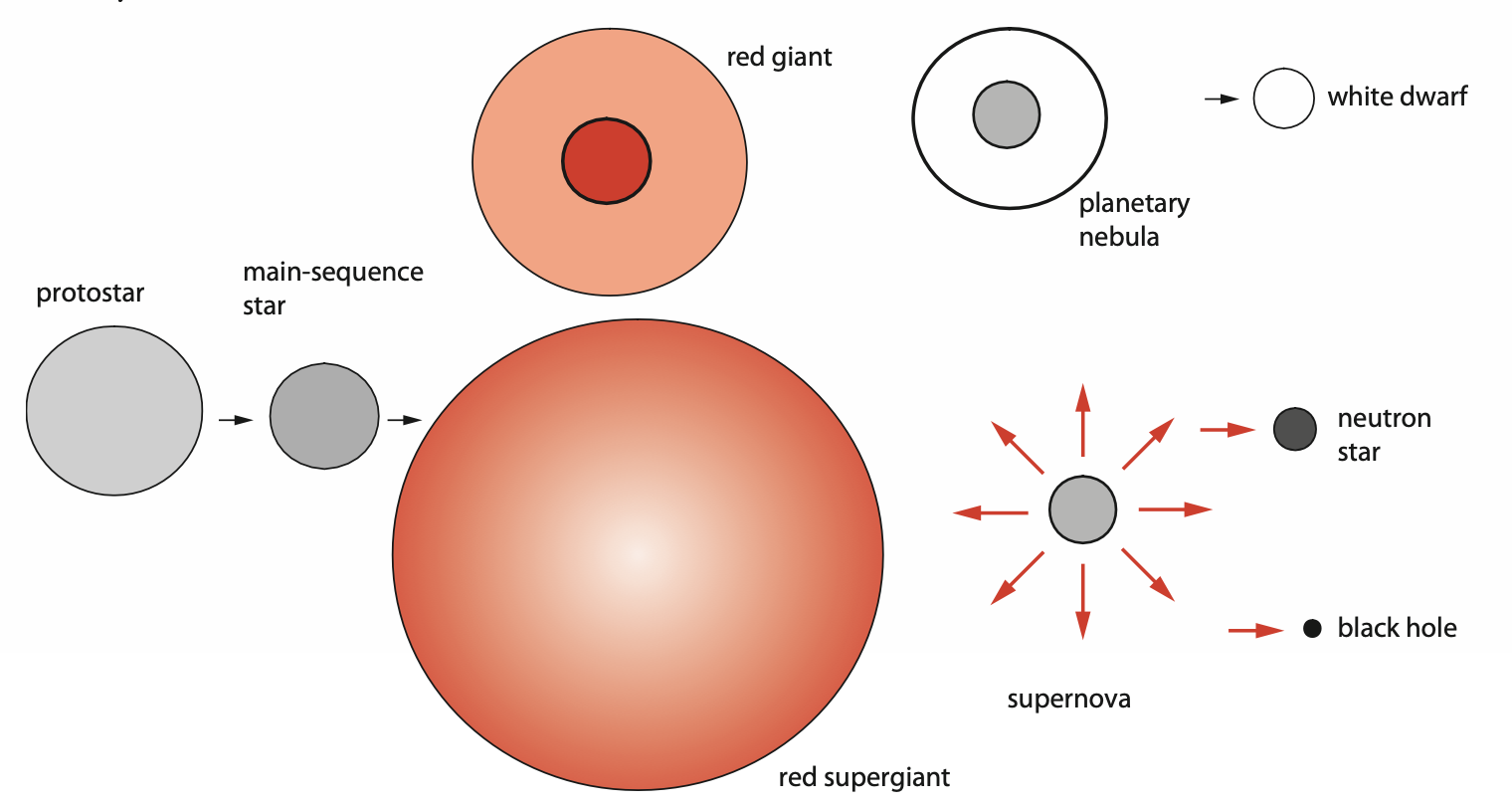
No Comments